Methane Leaks
Air Date: Week of June 14, 2013
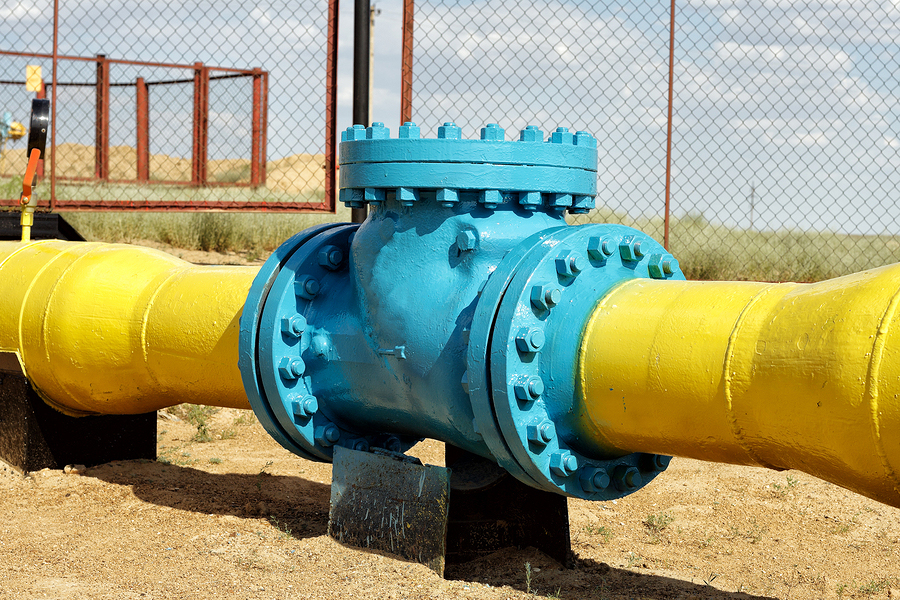
The valves on natural gas pipeline are a source of leaking methane. (Photo: bigstockphoto.com)
A new report from the Center for Climate and Energy Solutions, C2ES, pegs US carbon dioxide emissions at levels not seen since the mid 1990’s. Natural gas replacing coal for power generation has helped to lower emission rates, but methane leaks from wells and pipelines adds a powerful greenhouse gas to the atmosphere. C2ES president Eileen Claussen explains the methane leaks to host Steve Curwood.
Transcript
CURWOOD: The Center for Climate and Energy Solutions just reported that CO2 pollution in America is at rates last seen in the mid 1990’s, partly due to power plants switching from coal to cheaper natural gas. While gas is less polluting than coal, it still pollutes, and its main ingredient, methane, often leaks from wells and pipelines. Eileen Claussen, former Assistant Secretary of State and now President of the Climate Solutions Center, joins us now from Washington, DC.
CLAUSSEN: There's no question that if natural gas replaces coal in power plants there’s a net benefit for the climate. But natural gas is a fossil fuel and burning it does result in greenhouse gas emissions - and there’s always been some amount of leakage. It’s really an issue of the wells and the pipelines. The numbers are not huge, but methane is a potent greenhouse gas. And one of the challenges is to make sure there are virtually no leaks of methane as we move natural gas to the power plant, to the home, to the manufacturing facility.
CURWOOD: Where does this methane come from? You say pipeline and wells...what about fracking?

C2ES President Eileen Claussen (Photo: C2ES)
CLAUSSEN: We actually don’t have very good data to know whether fracking itself is part of the problem here. There is an effort underway right now to do some real measurements so we will have a handle on how much methane is being released, where it is being released, and then we can apply the technological solutions that we know work to wherever those leaks are or could be.
CURWOOD: So these numbers look quite small. You say we’re down to one and a half percent of methane escaping. Why is that a problem?
CLAUSSEN: Well, let me say that one and a half percent is an EPA estimate and we don’t actually know whether that’s the right number or not. But there are many sources of methane. I mean, natural gas leaks is a relatively small amount compared to livestock or landfills or other ways that methane gets into the atmosphere. But that doesn’t mean it’s not a problem because methane is a very potent greenhouse gas with a relatively short lifetime. So it’s more potent than carbon dioxide, but carbon dioxide lives in the atmosphere much longer. So if you want to make short term gains in addressing greenhouse gas emissions, dealing with methane is really important. But we actually have a lot to do to deal with methane across the board and globally as well.
CURWOOD: By the way, how do you detect and then manage a methane leak?
CLAUSSEN: Well, there are a whole lot of technical and engineering solutions that can help here. There are zero-bleed pneumatic controllers; there are good valves, improved valves; there are corrosion resistant coatings; there are dry seal compressors. We can do a much better job of leak detection and leak repair, and make sure not much actually gets out. From an engineering or technical point of view, there are actually a lot of things that can be done and we should do them.
CURWOOD: You would think the industry would want to do this. I mean, every time they lose a molecule of methane, then they’re losing money, right?
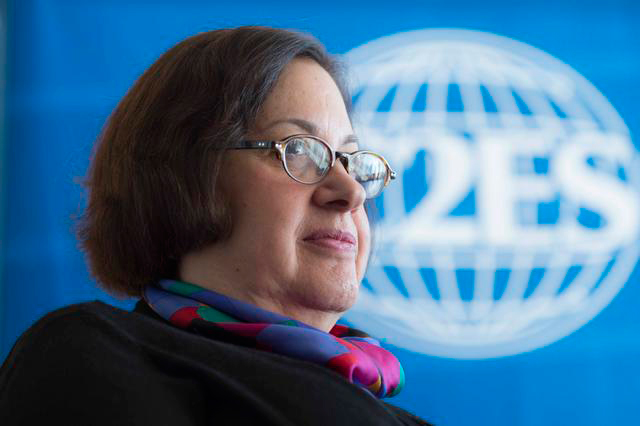
C2ES President Eileen Claussen at the Natural Gas Report release (Photo: C2ES)
CLAUSSEN: Well, absolutely, and all the efforts to date, let’s say over the last ten years or so, have been undertaken voluntarily by the industry. EPA estimates - and these are estimates - that leaks from natural gas systems declined by about 10 percent between 1990 and 2011 even with the expansion of natural gas infrastructure. So there is an effort to make sure that the methane is captured, and we’re hoping that those efforts continue and are speeded up so that we don’t end up emitting greenhouse gases from our natural gas systems.
CURWOOD: Where else besides electricity generation might we substitute natural gas to reduce carbon dioxide emissions?
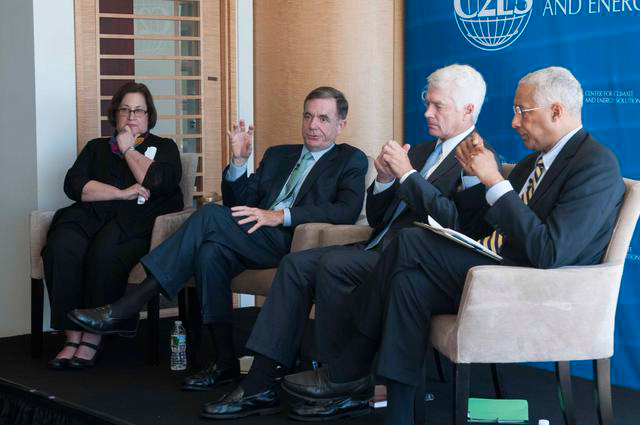
The CEOs of the Center for Climate and Energy Solutions discuss the emissions of natural gas at the release of the report. (Photo: C2ES)
CLAUSSEN: There are a couple of other uses that I think could be really valuable. Heavy duty trucks and fleets often use diesel. There would be a real environmental benefit to replacing that with natural gas. In home heating and home appliances, we use a certain amount of natural gas, but the more natural gas we use the better off we’ll be because there’s a huge amount of energy loss in our electrical systems when you use electricity for heat and home heating and so on. And even in manufacturing, if we were to use combined heat and power, we would be emitting fewer greenhouse gases. So there actually are a lot of different places where increased use of natural gas would benefit the climate.
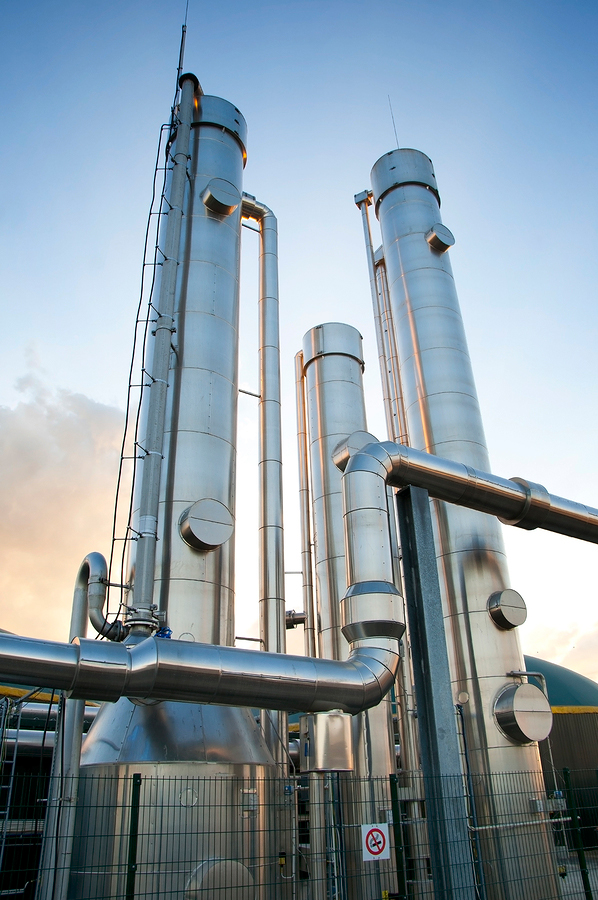
A natural gas power plant cuts down on carbon dioxide emissions but may increase more potent methane emissions. (Photo: bigstockphoto.com)
CURWOOD: The low price of natural gas these days has helped the tar sands extraction in Alberta. They use it to make it more liquid. How important is that use of natural gas?
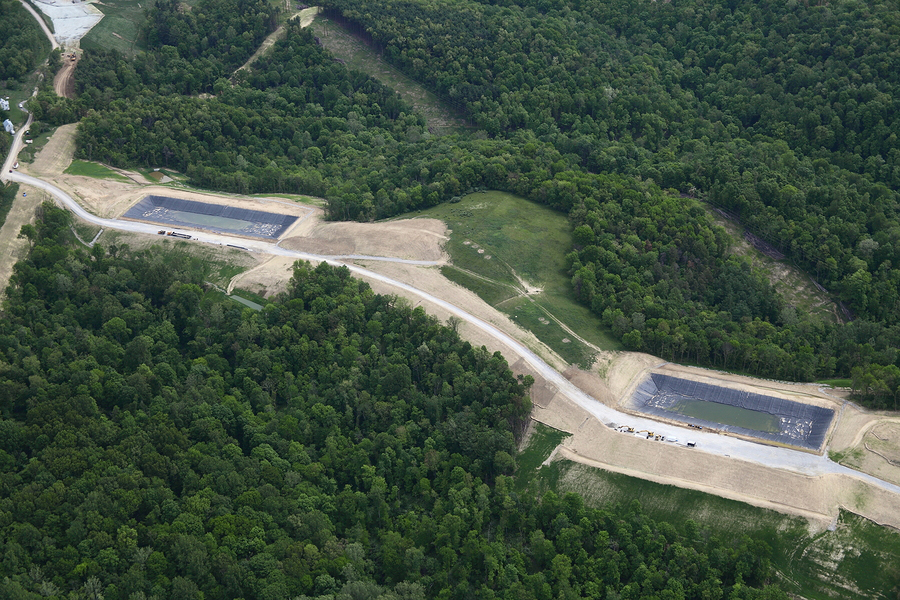
Natural gas wells may leak methane into the atmosphere. (Photo: bigstockphoto.com))
CLAUSSEN: [LAUGHS] It’s better than using something else. And there’s a bigger question, of course, about the tar sands themselves. When I look at the use of natural gas, I think that there’s no question that it’s a benefit, but if you’re using natural gas and, as a result of that, not using, for example, renewables, that is clearly not a benefit. So it’s a question of making sure you use natural gas in ways that actually provide you with a climate benefit.
CURWOOD: Now at the end of your report, you note that natural gas can’t be the long term solution. Why not?
CLAUSSEN: Well, I think natural gas is a bridge to a really clean energy future - a zero carbon future. It’s a pretty long bridge. We have a lot of natural gas. If we use it to substitute for other fossil fuels, greenhouse gas emissions will continue to go down. But again, we have to make sure that we have better solutions, whether it’s wind or solar or nuclear, by the time we get to 2030, 2040, 2050, if we really want to avoid serious climate change.
CURWOOD: Eileen Claussen is the President the Center for Climate and Energy Solutions Center in Washington. Eileen, thank you for joining us.
CLAUSSEN: It’s a pleasure.
Links
Living on Earth wants to hear from you!
Living on Earth
62 Calef Highway, Suite 212
Lee, NH 03861
Telephone: 617-287-4121
E-mail: comments@loe.org
Newsletter [Click here]
Donate to Living on Earth!
Living on Earth is an independent media program and relies entirely on contributions from listeners and institutions supporting public service. Please donate now to preserve an independent environmental voice.
NewsletterLiving on Earth offers a weekly delivery of the show's rundown to your mailbox. Sign up for our newsletter today!
 Sailors For The Sea: Be the change you want to sea.
Sailors For The Sea: Be the change you want to sea.
 The Grantham Foundation for the Protection of the Environment: Committed to protecting and improving the health of the global environment.
The Grantham Foundation for the Protection of the Environment: Committed to protecting and improving the health of the global environment.
 Contribute to Living on Earth and receive, as our gift to you, an archival print of one of Mark Seth Lender's extraordinary wildlife photographs. Follow the link to see Mark's current collection of photographs.
Contribute to Living on Earth and receive, as our gift to you, an archival print of one of Mark Seth Lender's extraordinary wildlife photographs. Follow the link to see Mark's current collection of photographs.
 Buy a signed copy of Mark Seth Lender's book Smeagull the Seagull & support Living on Earth
Buy a signed copy of Mark Seth Lender's book Smeagull the Seagull & support Living on Earth

